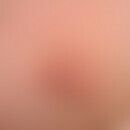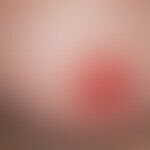Synonym(s)
HistoryThis section has been translated automatically.
DefinitionThis section has been translated automatically.
Unilateral, primarily intraductal adenocarcinoma penetrating the epidermis with eczema-like changes in the area of the nipple and areola. S.a. extramammary Paget's disease.
You might also be interested in
EtiopathogenesisThis section has been translated automatically.
It is discussed whether Paget's cells are derived from Toker cells (clear cell epithelia) which are physiologically present in the nipple and vulva epithelium.
ManifestationThis section has been translated automatically.
Mainly occurring in women after the 4th decade of life; the average age in larger studies is 54 years.
LocalizationThis section has been translated automatically.
nipple, areola and beyond. Unilateral, not symmetrical.
ClinicThis section has been translated automatically.
- Slowly growing from an inconspicuous red papule or plaque, not very symptomatic (important: nipple eczema itches!), usually sharply defined, reddened and scaly (eczema-like) plaque (the most important differential diagnosis is atopic nipple eczema). Continuous surface growth leads to plaques up to 5.0-8.0 cm in diameter. It is not uncommon for them to be weeping, scaling or scaly crusts. In case of invasive growth development of nodules. Painful ulcer formation can occur with advanced findings.
HistologyThis section has been translated automatically.
In a mostly hyperplastic and parakeratotic epidermis there are single or numerous, shot-blasted, scattered, large, bright cells with large pleomorphic nuclei (Paget cells). These are CEA- and PAS-positive and also stain with low-molecular cytokeratins.
Differential diagnosisThis section has been translated automatically.
Breastadenoma (erosive adenomatosis of the nipple); keratosis areolae mammae naeviformis; nipple eczema; Bowen's disease; scabies; psoriasis vulgaris.
TherapyThis section has been translated automatically.
Notice!
In case of chronic, therapy-resistant "nipple eczema" always remember M. Paget's nipple! After 3 months of treatment at the latest without success, histological confirmation!LiteratureThis section has been translated automatically.
- Belousova IE et al (2006) Vulvar toker cells: the long-awaited missing link: a proposal for an origin-based histogenetic classification of extramammary paget disease. At J Dermatopathol 28:84-86.
- Hashemi P et al (2014) Multicentric primary extramammary Paget disease: a Toker cell disorder? Cutis 94:35-38.
- Kothari AS et al (2002) Paget disease of the nipple: a multifocal manifestation of higher-risk disease. Cancer 95: 1-7
- Paget J (1874) On disease of mammary areola preceding cancer of mammary gland. St Barth Hosp Rep 10: 87-89
- Marshall JK et al (2003) Conservative management of Paget disease of the breast with radiotherapy: 10- and 15-year results. Cancer 97: 2142-2149
- Requena L et al (2002) Pigmented mammary Paget disease and pigmented epidermotropic metastases from breast carcinoma. At J Dermatopathol 24: 189-198
- Stanganelli I et al (2014) Atypical pigmented lesion of the nipple. J Am Acad Dermatol 71:e183-185
- Willman JH et al (2005) Vulvar clear cells of Toker: precursors of extramammary Paget's disease. At J Dermatopathol 27:185-188.
Incoming links (14)
Anal fissure; Bowen, john templeton; Breast adenoma; Breast cancer; Breast dermatitis; Cancer eczema; Carcinoma breast carcinoma; Collagenosis reactive perforating; Cytokeratin 18; Pagetoid; ... Show allOutgoing links (8)
Bowen's disease; Breast adenoma; Breast dermatitis; Keratosis areolae mammae naeviformis; Paget's disease extramammary; Psoriasis vulgaris; Skabies; Toker cell;Disclaimer
Please ask your physician for a reliable diagnosis. This website is only meant as a reference.








